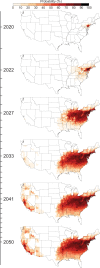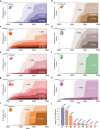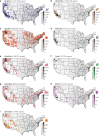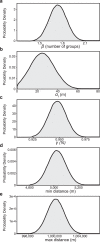Spotted lanternfly predicted to establish in California by 2033 without preventative management
- PMID: 35676315
- PMCID: PMC9177847
- DOI: 10.1038/s42003-022-03447-0
Spotted lanternfly predicted to establish in California by 2033 without preventative management
Abstract
Models that are both spatially and temporally dynamic are needed to forecast where and when non-native pests and pathogens are likely to spread, to provide advance information for natural resource managers. The potential US range of the invasive spotted lanternfly (SLF, Lycorma delicatula) has been modeled, but until now, when it could reach the West Coast's multi-billion-dollar fruit industry has been unknown. We used process-based modeling to forecast the spread of SLF assuming no treatments to control populations occur. We found that SLF has a low probability of first reaching the grape-producing counties of California by 2027 and a high probability by 2033. Our study demonstrates the importance of spatio-temporal modeling for predicting the spread of invasive species to serve as an early alert for growers and other decision makers to prepare for impending risks of SLF invasion. It also provides a baseline for comparing future control options.
© 2022. The Author(s).
Conflict of interest statement
The authors declare no competing interests.
Figures







References
-
- Wakie TT, Neven LG, Yee WL, Lu Z. The establishment risk of Lycorma delicatula (Hemiptera: Fulgoridae) in the United States and gobally. J. Econ. Entomol. 2020;113:306–314. - PubMed
-
- Namgung H, Kim M-J, Baek S, Lee J-H, Kim H. Predicting potential current distribution of Lycorma delicatula (Hemiptera: Fulgoridae) using MaxEnt model in South Korea. J. Asia-Pac. Entomol. 2020;23:291–297. doi: 10.1016/j.aspen.2020.01.009. - DOI
-
- Jung J-M, Jung S, Byeon D, Lee W-H. Model-based prediction of potential distribution of the invasive insect pest, spotted lanternfly Lycorma delicatula (Hemiptera: Fulgoridae), by using CLIMEX. J. Asia-Pac. Biodivers. 2017;10:532–538. doi: 10.1016/j.japb.2017.07.001. - DOI
-
- Hao T, Elith J, Guillera‐Arroita G, Lahoz‐Monfort JJ. A review of evidence about use and performance of species distribution modelling ensembles like BIOMOD. Divers. Distrib. 2019;25:839–852. doi: 10.1111/ddi.12892. - DOI
-
- Meentemeyer RK, et al. Epidemiological modeling of invasion in heterogeneous landscapes: spread of sudden oak death in California (1990-2030) Ecosphere. 2011;2:art17. doi: 10.1890/ES10-00192.1. - DOI
Publication types
MeSH terms
LinkOut - more resources
Full Text Sources

